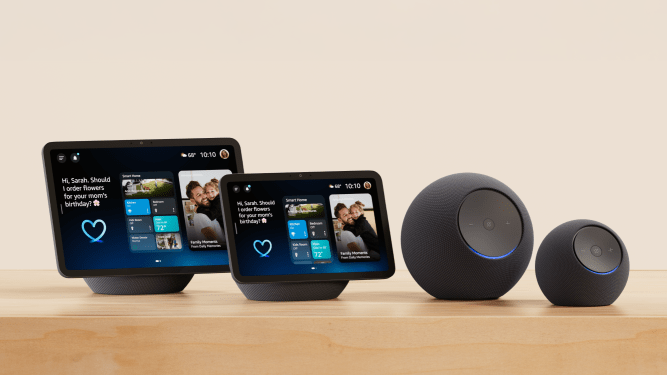At its annual hardware event, Amazon introduced a new lineup of Echo devices built specifically for its AI assistant, Alexa+, which has already rolled out to millions of customers through its early access program. To showcase the AI’s capabilities, Amazon is releasing four new Echo devices with improved processing power and memory: the Echo Dot Max, Echo Studio, Echo Show 8, and Echo Show 11.
Key to the devices are the Alexa+ integrations, allowing the speakers to respond to more queries than earlier models. The AI offers support for natural language conversations and more complex questions. Soon, it will include more add-ons and capabilities. This will later include an Alexa+ Store, where users can explore services from brands like Fandango, GrubHub, Lyft, Priceline, Taskrabbit, Thumbtack, and Yahoo Sports. The devices will also be able to manage new or existing subscriptions with Amazon’s own services like Amazon Music, Amazon Kids+, or Alexa Emergency Assist, allowing users to customize their Alexa experience.
The new Echo devices run on Amazon’s custom-designed silicon chips, the AZ3 and AZ3 Pro, which include an AI Accelerator designed to run AI edge models. The AZ3 enables better conversation detection on the Echo Dot, letting people talk to the device from anywhere in the room while still filtering out background noise. Amazon claims the chip also improves detection of the wake word by over fifty percent.
The other three devices, the Studio, Show 8, and Show 11, use the AZ3 Pro. This chip adds support for advanced language models and vision transformers. The AZ3 Pro-enabled devices also include Ominisense, a custom sensor platform for ambient AI. This platform uses the 13-megapixel camera on the new Echo Show devices, along with audio, ultrasound, Wi-Fi radar, accelerometer, and Wi-Fi channel state information. With this feature, the devices allow Alexa to act on events happening in the home, such as delivering a reminder when a particular person walks in the room or alerting you to an open garage door before you go to bed.
The new Echo Dot Max is priced at ninety-nine dollars and ninety-nine cents and adds nearly three-times the bass for better sound. Its two-way speaker includes a woofer for deep bass and a custom tweeter for the high notes.
The Echo Studio costs two hundred nineteen dollars and ninety-nine cents and features a new spherical design, which Amazon says makes it forty percent smaller than the original. The Echo Studio also includes a high-excursion woofer, spatial audio, Dolby Atmos, and an upgraded light ring for better visual understanding of what Alexa is doing. The company notes that consumers can connect up to five Echo Studio or Echo Dot Max devices with compatible Fire TV sticks for an immersive sound system in their home. Amazon plans to sell these products in Alexa Home Theater bundles.
Also new are two smart displays, the Echo Show 8 for one hundred seventy-nine dollars and ninety-nine cents and the Echo Show 11 for two hundred nineteen dollars and ninety-nine cents. Both have a new design, improved picture quality, a 13-megapixel camera, a larger screen area, new front-facing stereo speakers, a custom woofer, and Alexa+ powered features.
The AI assistant will run a new smart home experience called Alexa+ Home. This combines features like event summaries from Ring camera feeds and a smart home hub that supports Matter, Thread, and Zigbee. As devices with a screen, the displays are well-suited for accessing entertainment, such as streaming audio and video, managing home organization and family activities, and handling household shopping needs. The shopping feature integrates with Amazon, Whole Foods, and Amazon Fresh to make re-ordering favorites and delivery tracking easier.
Additionally, Amazon is teaming up with smart ring maker Oura to bring personalized health and wellness suggestions to Alexa devices. This integration could help by adding workout reminders or nudges to head to bed for better sleep. Support for other devices from Withings and Wyze is planned for the future.

